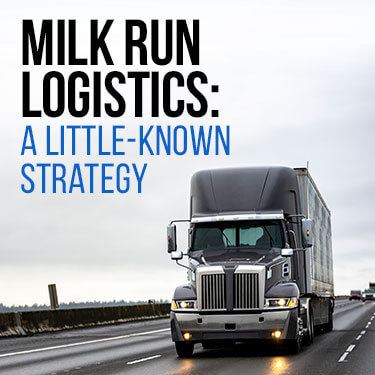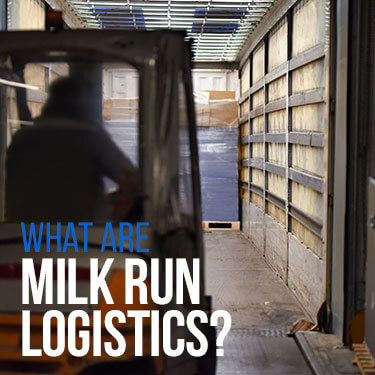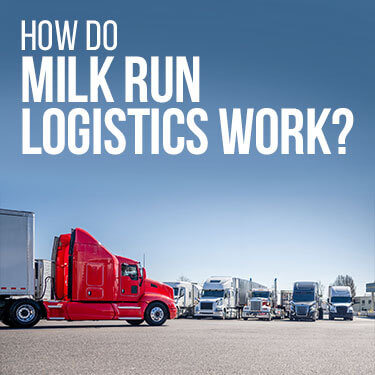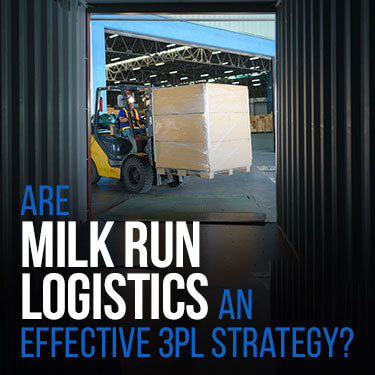
 Copy URL to Clipboard
Copy URL to Clipboard
In any supply chain, there is a straightforward and desired method behind obtaining goods, transporting them to a warehouse or distribution hub, and then routing them all over the country. To be effective in this process, you will need a winning strategy, and milk run logistics just might be the answer.
Milk run logistics is a consolidated method of procuring goods and distributing them using lean logistics. Established routes for a single transport with multiple mixed loads from several suppliers to a single warehouse facility or distribution center is the central part of what makes this system of logistics work.
What does milk run mean in logistical terms? Is this something that is exclusive to the dairy industry? Find answers to that question and more in the article below.
Table of Contents

This form of logistics is a tried and tested delivery solution that moves goods from various suppliers to an end-stage destination such as a warehouse or distribution center. This “supplier sending” method is accomplished by using a fixed route with a single supply vehicle carrying multiple mixed loads.
The term “milk run” in logistics stems from a process in the dairy industry conceived in the early 1900s to save money on the delivery method used to transport dairy products. This process achieved two goals:
What does all this mean, you might ask? Transport yourself back to the early 20th century. Horse-drawn carriages are still very much in use, and the “milkman” of the day would drive around his route delivering milk and picking up mixed load milk bottles for dairy farms to fill his cart.
Then after his cart was loaded with milk from several dairy farms, he would make his delivery rounds of fresh milk to each residence. Once the milkman arrived at the residence, he would replace the empty bottles with fresh ones.
This process saved costs on using multiple horse-drawn carriages and also provided the milkman with an idea of consumer demand in the same instant, making the “collect milk run as a delivery method.”
Essentially the process is the same today - a single route between multiple suppliers with an end destination to supply chains, distribution centers, or warehouses.

A milk run system is constantly rotating like a wheel on a bike, meaning it is continuously in motion. The process is highlighted by the fact that in a single transportation route, a truckload driver can acquire goods from several different suppliers in a single load and then deliver them to a warehouse or distribution center.
Once a delivery has been made:
For a supplier moving goods regularly through a supply chain, this method helps to keep levels of overstocking low while minimizing the risk of stockouts or other supply chain failures. The demand for goods regularly helps define supply chain distribution and optimization strategies.
This logistics method helps to ensure real-time acquisition doesn’t exceed or fall short of demand while producing a daily supply of goods from all available sources. Milk runs are favored by manufacturing facilities due to the ability to keep goods flowing regularly.
The milk run supply chain strategy requires accuracy and real-time information to be as productive as the system suggests. In the early 20th century, this method could operate on the manual application of fulfillment and distribution.
Today, milk run routes are conducted using multiple forms of equipment, including manual and automated systems for warehouses and distribution centers. In the modern era of supply chain management, using the latest software and equipment is required to keep up with retail and eCommerce consumer demand.
Examples of the required equipment in milk run logistics are:
Times change, and so does consumer demand and technology. A modernized and efficient fulfillment & distribution system offers any supply chain the greatest chance of success. When using the milk run logistics method, it is essential to have the proper equipment on site with the appropriate implementation.

In the modern era, supply chains, and distribution networks are vast. They require an interconnected system that can communicate with multiple suppliers simultaneously while performing complex calculations and task management.
The following benefits become a reality through advanced warehouse management systems (WMS) and radio frequency identification (RFID):
Through the use of conveyor systems, tugger trains, along with the above-mentioned digital advances in logistics, the flow of a milk run operation is fast and efficient. This system of logistics relies entirely on smooth operation, reliable staffing, advanced equipment, and digital technologies to be a success.
Optimizing standardized equipment and advanced technologies in this style of logistics goes a long way. Each supplier has a fixed schedule that is mapped out around arrival times of pickups so the loading staff can be efficient.

Using a tried and tested logistics system may not seem complicated on the face of things. However, like anything, perfecting the strategy and execution of milk run logistics is no small feat, but when accomplished it is a very effective means for fulfillment and distribution.
Like any other logistics strategy, the process has pros and cons that depend strictly on its execution. Reduced travel times through fewer transport vehicles through mixed load pickup and deliveries can garner some impressive results at a lower cost.
Regardless of the pros and cons, proper facilitation and execution are required to reap the benefits of this tried and tested logistical strategy.
A failure to properly execute an effective milk run strategy can prove disastrous. Every single route depends on a fixed schedule of operations, with each point in a single route being reliant upon the other.

Using a trusted third-party logistics partner (3PL) is the best option to facilitate an effective milk run strategy for your supply chain. Doing so will garner the best in advanced technology, operational know-how, maximized efficiency, and real-time transparency.
Milk run logistics requires a reliable fleet of trucks, up to date distribution facility, and operational management with extensive transport networks in place. You don’t need to figure things out on your own. A trusted 3PL can put their infrastructure to work for you instantly.
The following services are available on day one:
How can you determine if milk run logistics will ultimately be effective? The answer largely depends on your business type and daily needs.
This logistics strategy strongly favors lean manufacturing to replenish commodities regularly. Severely reduced transport routes offer a more sustainable and reliable flow of products at a constant pace.
| 2015 | 2016 | 2017 | 2018 | 2019 | 2020 |
| 31.1 Billion | 31.6 Billion | 34.3 Billion | 39.4 Billion | 40.1 Billion | 40.2 Billion |
A trusted 3PL has the resources, network partnerships, equipment, and operational experience needed to successfully implement this type of fulfillment and distribution strategy to its maximum potential. As shown in the table above, the 3PL industry grows exponentially annually due to its ability to facilitate business strategies to their highest potential.
The cost of setting up the framework and daily use of this system can be prohibitive. Also, the management and workforce required must be knowledgeable and experienced to offer the highest level of success. Using a trusted 3PL, you can save time and money while using the best resources available.
Here at R+L Global Logistics; our priority is you and your business. We take the needs and goals of your business to heart as if it was our own. We have knowledgeable and friendly experts just waiting to assist you in any fulfillment & distribution endeavor you may have.
We have over 80 years of experience under our belt as one of the largest 3PL partners. Our expanded network, partnerships, a fleet of transport vehicles, warehouses, distribution centers, and more offer a truly world-class experience and service level to all our customers.
Our staff is standing by, ready and eager to assist you in implementing various logistical strategies just like the milk run system to maximize your business potential. Call us at (866) 353-7178 or click below for a fast and friendly quote today.
